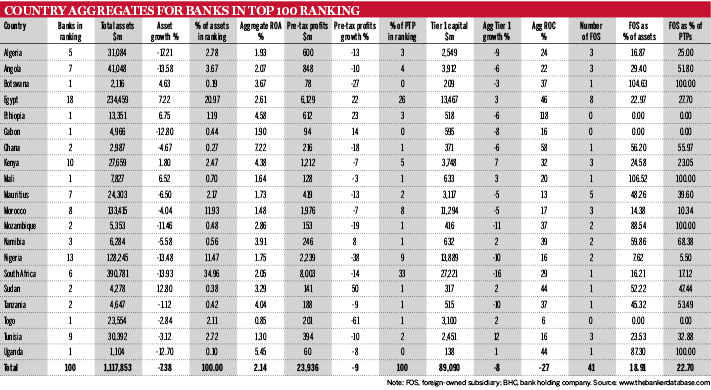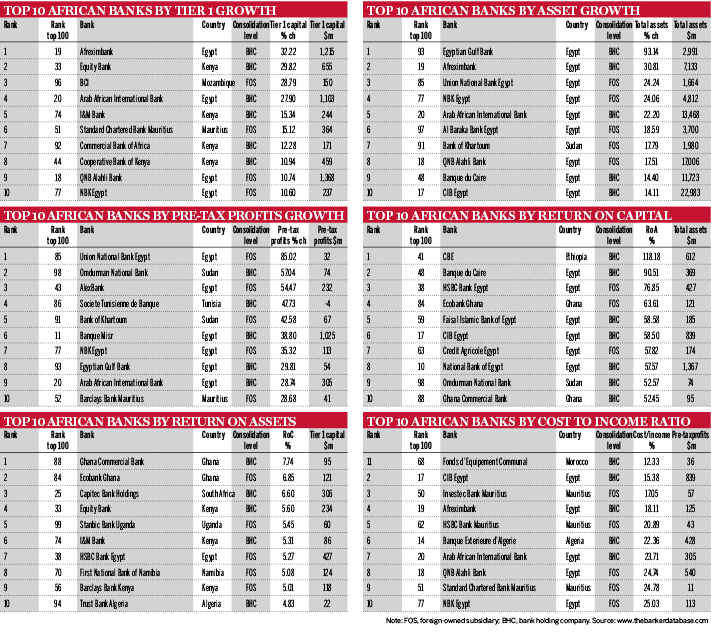Very few of Africa’s leading economies have emerged unscathed from the challenges of recent years. Lower commodity prices, cooling global growth and, in some cases, political instability have all exacted a heavy toll on key markets across the continent.
The Banker’s 2017 African banks ranking illuminates these trends clearly; only five lenders in the top 20 banks measured by Tier 1 capital registered an increase to their capital positions over the review period (to year-end 2015). This is mirrored in aggregate terms with a year-on-year 8% contraction in Tier 1 capital across all of the banks included in the ranking.
For some markets, the volatile currency movements that accompanied many of these macroeconomic difficulties go a long way to explaining this poor performance. The value of the South African rand, the Nigerian naira and the Mozambican metical, among many others, all slid considerably against the dollar in 2015. Nevertheless, these are undoubtedly leaner times for Africa’s lenders. As profits dip and asset quality deteriorates, some banks are now finding themselves overexposed to once-dominant sectors, including oil and gas.
Pre-tax profits down
As such, the pre-tax profit growth of banks in resource-dependent economies were hit particularly hard. In Nigeria, Angola and Algeria, the pre-tax profits of banks in this year’s ranking contracted by 38%, 10% and 13%, respectively. Across the ranking as a whole pre-tax profits fell by 9%. This trend was mirrored in the performance of African banks by their total assets, with an aggregate drop of -7.38% over the review period.
Though the overall picture represents a steep decline on the 2016 ranking, which covered data to the year-end of 2014, the story is far from one-dimensional. The Banker’s data clearly demonstrates the emergence of new, if lesser known, growth stories from across the continent. These markets have for the most part avoided the resource curse while benefiting from the growth opportunity presented by large and unbanked populations.
In this regard, the Commercial Bank of Ethiopia tops the return on capital table with 118%, an impressive performance given that it was in 41st place based on its Tier 1 capital position.
Sudan’s Omdurman National Bank also features in the top 10 banks by return on capital this year, coming ninth, while it lands second position in the pre-tax profit stakes with a 57% year-on-year increase totalling $74m for the review period. This capped off a strong year for the two Sudanese banks in the rankings, with the Bank of Khartoum coming in at seven based on its asset growth. The country’s underbanked population and more stable operating environment partly explain this performance.
Based on Tier 1 capital growth, this year’s top 10 is absent of any lenders from west Africa compared with five in the 2016 ranking. Instead, the table is dominated by banks from Kenya, which account for four positions, with a further three being taken by lenders from Egypt.
Egypt's rise
The strong performance of Egyptian banks across all categories builds on a similar showing in the 2016 rankings. It should be noted, however, that the performance this year occurred when the Egyptian pound was pegged to the dollar, and does not take into account the devaluation that occurred in the later stages of 2016. To some extent, this accounts for the slide of other lenders relative to their Egyptian counterparts in the latest African banks data.
Elsewhere, banks from Namibia performed admirably. By most metrics, Namibia’s three largest lenders either equalled their 2016 performance or exceeded it and by doing so positioned the country as one of the region’s standout markets. Their aggregate return on assets hit 3.91%, up from 3.65% in 2016's ranking. Meanwhile, pre-tax profit and Tier 1 capital grew by 8% and 2%, respectively.
But for Africa’s biggest hitting banking markets, and the largest lenders within them, this has largely been a troubling period. South Africa’s Standard Bank, the continent’s largest bank by total assets and Tier 1 capital, saw both of these metrics contract by over 20% in the review period.
This rounded off a poor year for South African banks, with all but one of the six lenders in the ranking, Capitec Bank, posting declines in Tier 1 capital. Similarly, Capitec was the only South African institution to post positive asset growth.
In Nigeria it was a similar story. All but two of the country’s 13 banks in the 2017 rankings registered declines in Tier 1 capital. Similarly, only two banks, United Bank for Africa and Access Bank, recorded positive pre-tax profit growth.
As a whole, the continent is a long way from recovery. The International Monetary Fund expects the sub-Saharan economies to grow by just 1.6% in 2016, a stark reduction from growth rates of previous years. But despite the more challenging environment, positive stories continue to emerge, as new markets look set to champion a more diverse growth trajectory in the coming years.













